Ysartnews Issue 3 - September 1987
With added comments/updates, 2001, 2002.
Edited by Mary Houston-Lambert 2002
Editorial
Identifying Ysart Glass (Part One) External Page
Calendar of Ysart Glass External Page
Schneider Glass External Article
British Glass Between the Wars
Photographs from Vasart period
Editorial
Thank you for all the material sent in. Please keep it coming and do let me have some comments on the contents of this newsletter. It will be very helpful. I can see that the aims of the club to encourage research have been successful and the first fruits of our joint efforts appear in this issue. The promised article on Paul Ysart is missing this time because you sent so much material that sorting it out is going to need more time. There are many inconsistencies between the various accounts; I hope to have an article for the next issue. Some of the submitted material has been included in this issue. We have arranged a meeting between Paul Ysart and Alison Clarke who has been analysing all the material received.
A lot has happened with Ysart Glass since the last issue and the most important is the prominent position given to Monart in the Stourbridge ‘Between the Wars’ exhibition catalogue. The article on Monart Glass announces the connection of Salvador Ysart and Schneider in France before the First World War. Its author Ian Turner has spent a lot of time with Paul Ysart discussing Monart Glass and the family history.
Raoul Arantes has produced a brief history of Schneider for us. I suspect that Salvador also worked for Legras in France but have not yet found any corroborative evidence other than some of the glass brought to England by the family.
I have had the honour of meeting and talking at great length with the widow of Vincent Ysart and have learnt much more about the Vasart production. The biggest surprise for me was the quality of paperweights that were produced in addition to the familiar but fairly crude weights produced for the mass market. I knew that Salvador was capable of fine work in paperweights but had not realised the extent to which they were produced under Vasart. Another member has produced a fair amount of information from newspapers in Scotland. After this newsletter, I plan to follow up contacts with the Scottish press. If anyone is planning any casual or serious research, please contact me first as there is still much work to be done in many specific areas.
Agreements for the first book on Ysart Glass are being discussed and I hope to see it published during the first half of 1988.
Unfortunately, the seminar has been cancelled this year due to time constraints. Hopefully we can get this organised for next year sometime.
Finally, membership renewals will be due before the next issue and the fee will have to be increased. I will write to you all later in the year. We have 39 members to date and have recently received enquiries from Australia and France. USA membership is slowly developing.
Thanks for all the help. Please keep it coming.
Frank Andrews, August 1987.
Identifying Ysart Glass (Part One)
Identifying Ysart Glass (Part One)External Page
The second part of this article will be on the Identification of Ysart Paperweights. Colour photographs of weights seem to photocopy quite well and I would appreciate as many confirmed examples as possible for the compilation of the article.
One factor that appears to be constant in Monart weights is that the colour of the glass casing is very dark when compared with any other makerīs work. In some examples the darkness is extreme and mutes the colours of the design.
STOP PRESS
A type of glass that until now has been attributed to Monart has been wrongly attributed. Every piece that I have seen is a pale-green, unlike any Monart green, with splashes of bright colours (yellow, green and brown) on two sides and liberally sprinkled with gold aventurine. The base has the pontil completely ground out and polished smooth the edge of the base is unpolished. This is not to be confused with the Monart version which has the correct base and a common Monart shade of pale green. I will keep an example of this glass for inspection. The incorrect attribution has been confirmed by Paul Ysart. [2002. See Czech vase]
Calendar of Ysart Glass
This chart has now been updated and moved to a separate page: Calendar of Ysart Glass
Schneider Glass
This article is now a separate page: Schneider Glass
British Glass Between The Wars
This exhibition was held at Broadfield House Glass Museum in Stourbridge, from June to August this year.
The Monart case contained about twenty items, including a ‘Monart’ period millefiori inkbottle by Salvador. From the Victoria & Albert Museum collection there was the only ‘handled’ example of Monart that I have seen, an 8cm high vase of uncased iridescent finish. There was a good selection of unusual and early pieces of Monart but unfortunately little of the more common production was included. Several members who were able to visit the exhibition voiced this criticism to me. For collectors familiar with the glass it was good to see the rarer pieces but for new collectors not very helpful.
The Whitefriars display was very interesting showing a large range of that factory’s mammoth production. Missing were the strong coloured pieces that are sometimes mistaken for Monart but the pieces on show made that seem unimportant. Item 249, a heavy clear green glass cylindrical vase decorated with deep vertical grooves alternating with roundels, was for me the best piece in the exhibition.
Gray-Stan was well represented and contained many interesting examples showing the variety of their production.
A blue and white vase on display but not in the catalogue was identified as from Nazeing Glassworks in Hertfordshire. I had recently purchased a pink example of the same vase and was pleased to learn its source. This is another factory that produced pieces in a similar way to Monart and I shall try and get some more information about it.
Despite the minor criticisms about content, it was a very good exhibition. The museum also has a good permanent collection, which is well worth a visit. The superb catalogue with several well-researched articles and many photographs, eighteen in colour, is an invaluable reference work for anyone interested in this period of glass production.
Frank Andrews
The author of the article on Monart Glass in the exhibition catalogue, Ian Turner, is one of our founding members. A follow-up article on post-war production of Monart, by Ian, will appear in the October issue of ‘The Antique Collector’. The exhibition is moving to a new venue, probably in the North East of England. An exhibition of Whitefriars will be held in London later this year. Details of these will be sent out as soon as I have them.
Photographs
1. The Ysarts and their first staff at the Shore Works shortly after opening in September 1946.
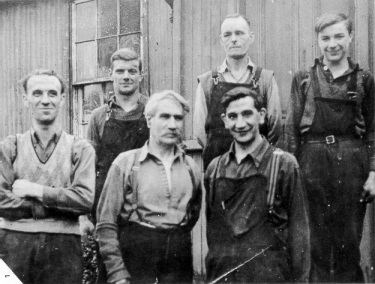
Front row left to right: Augustine Ysart, Salvador Ysart & Vincent Ysart. Back row: Bob Wishart (ex Moncrieff), Harry Lever and Boy (name not known). Later workers included Jack Allan, Albert Jolly, Andrew Moncrieff (not of the glass family), Joe Dickson (Grinder) and for the Downing Street globes Jesus Braso came out of retirement.
2. Shore Works, Shore Road, Perth.
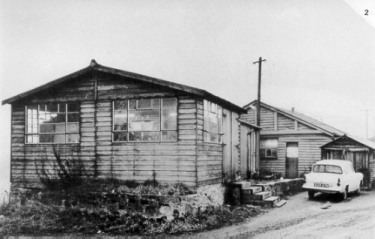
The nearest building was the decoration shop added sometime after Mr Dunlop of Pirelli Glass became involved in 1949. The Ford Anglia car probably belonged to Augustine. The Ysart brothers decorated supplied glasses for Babycham and Martini and a series of half and one-pint beer mugs with a Lion and town name transfer on for the souvenir trade.
3. Assembling paperweights.
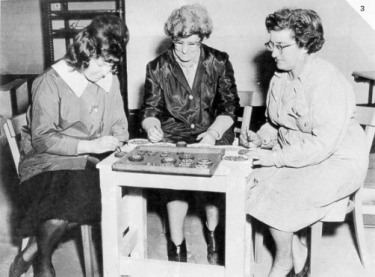
From left to right: Pat Allan, Catherine Ysart, Nelly Reid. Pat Allan was the wife of Jack Allan who also worked for the brothers as a glassblower; he now leads an itinerant lifestyle in and around Perth. (Date unknown)
4. Two Vasart paperweights and an inkbottle.
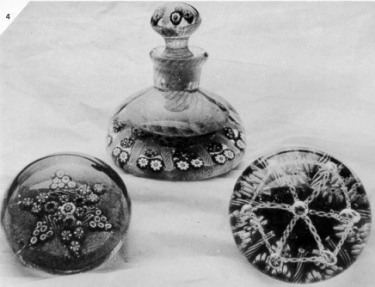
These inkbottles frequently appear in markets and fairs described as English c. 1850! A recent example, so described, in Portobello Road was priced at £150 complete with a massive crack.
5. Vincent Ysart making a Tulip lamp.
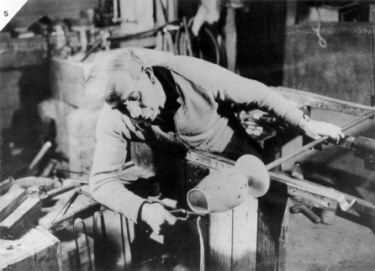
The photographs are reproduced with the kind permission of Catherine Ysart.